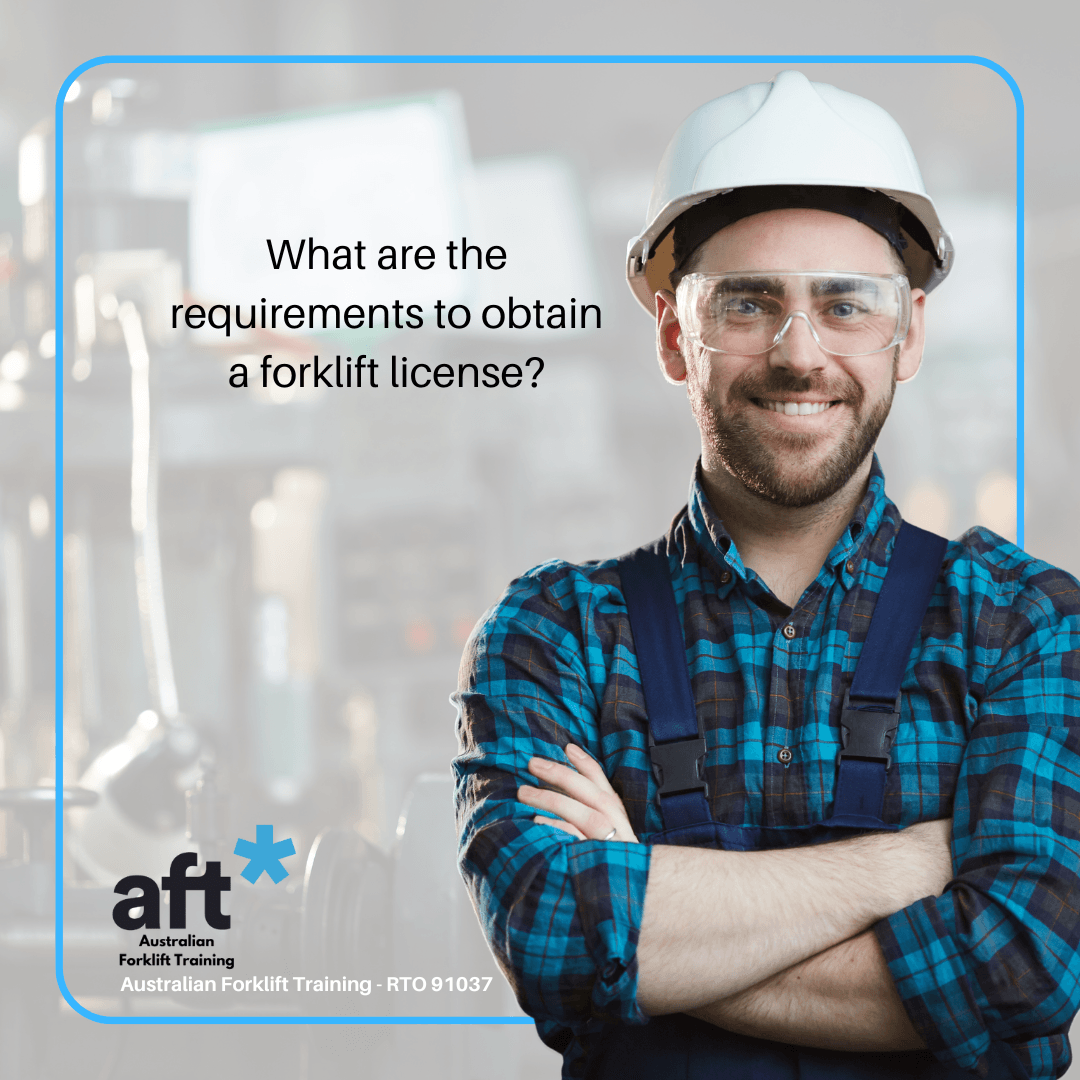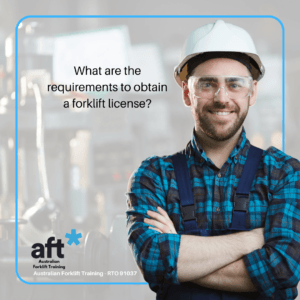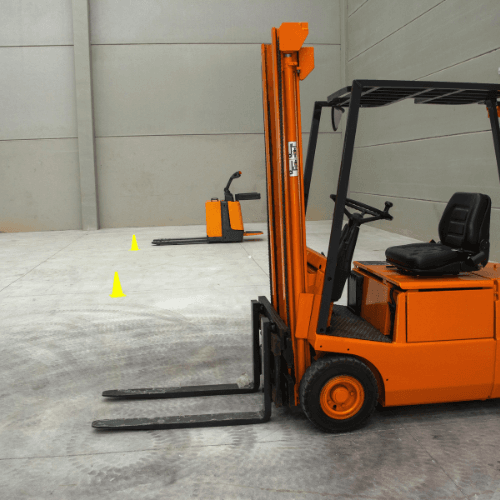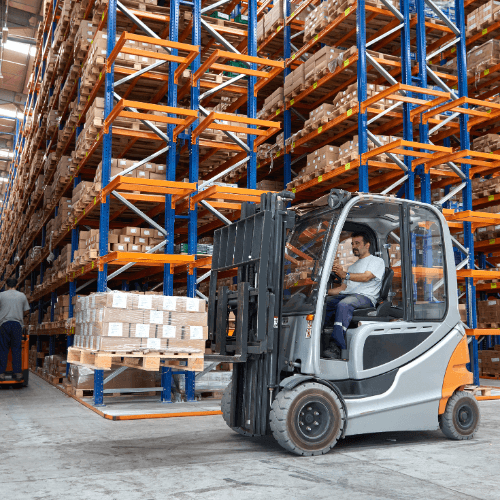
Is Forklift Training Hard to Pass? A Complete Guide to Certification Success
Is Forklift Training Hard to Pass? A Complete Guide to Certification Success
If you’re considering forklift certification but worried about the difficulty, you’re not alone. Many people wonder whether they’ll be able to pass the forklift test and earn their certification. The good news? Forklift training is generally not hard to pass for most people who prepare properly and stay focused during the process.
However, it’s important to remember that you will need to work hard and stay committed throughout your training to succeed.
With the right preparation and mindset, you can join the thousands of forklift operators who successfully earn higher starting pay and access better warehouse job opportunities through certification. This complete guide will walk you through everything you need to know about forklift training, difficulty, what to expect, and how to set yourself up for success.

The Quick Answer: Difficulty Level of Forklift Training
Forklift training is widely regarded as accessible and achievable for most individuals. Industry statistics consistently show a first-time pass rate between 85% and 95%, which means failure is relatively uncommon for those who adequately prepare and pay attention during training.
The skill set required for operating a forklift is often compared to learning to drive a car. Both involve mastering fundamental controls, developing situational awareness, and applying safety practices. Driving a forklift, however, requires unique skills and heightened attention, as the driver must be constantly aware of their surroundings, load stability, and safety precautions. With proper preparation, you can learn to drive a forklift today and drive it tomorrow. Forklift operation takes place in more controlled environments under the supervision of a qualified instructor.
To earn your forklift certification, you must pass both a written test covering safety regulations and theoretical knowledge, and a practical driving test demonstrating your hands-on skills. Wearing your seatbelt while operating a forklift is mandatory to pass the test. Additionally, you must know to check your mirrors and use the horn. Most people with basic mechanical aptitude and the ability to follow safety protocols succeed, provided they take their preparation seriously and don’t rush through the process.
The key difference between drivers who pass with flying colours and those who struggle is preparation and mindset. While forklift training isn’t overly difficult, it does require attention to detail, especially when it comes to safety procedures and equipment operation.
What Makes Forklift Training Challenging
While forklift certification isn’t fairly difficult for most people, there are specific aspects that can present challenges, especially for those new to operating heavy machinery. A forklift is a powerful machine that requires respect, careful handling, and strict adherence to safety protocols. These challenges are important to understand for any aspiring forklift operator.
Spatial Awareness and Navigation
One of the biggest challenges new forklift operators face is developing spatial awareness. Forklifts are often operated in warehouses with narrow aisles, close shelving, and various obstacles. You must learn to judge distances accurately and navigate tight spaces without causing damage to property or creating safety hazards. Paying attention to your surroundings at all times is critical for safe navigation.
Unlike driving a car on open roads, operating a forklift requires precise maneuvering in confined spaces where every inch matters. The overhead guard and mast can create blind spots that don’t exist in regular vehicles, so it’s important to stay aware of these blind spots and any obstacles in your environment, making spatial judgment even more critical.
Load Handling and Weight Distribution
Understanding load capacity and weight distribution represents another significant challenge. Forklift trucks can tip over if operators misunderstand center of gravity principles, exceed load limits, or fail to keep loads properly positioned. You must learn to apply the physics of stability triangles and understand how different load configurations affect the machine’s balance.
This includes knowing when loads are too heavy, how to position fork arms correctly, and understanding how the front axle bears the weight. It is also crucial to ensure the forklift remains stable on level ground to prevent instability. A common mistake that leads to dangerous situations is not tilting the mast back slightly when carrying loads or lifting them too high during transport, which increases the risk of accidents if loads are not carried and handled properly. Therefore, it is essential to learn proper techniques to carry heavy loads safely and efficiently, as forklifts carry large amounts of weight and energy, which can pose significant safety risks if not handled correctly.

Reverse Driving and Control Differences
Many forklift operators find reverse driving with loads particularly challenging. The movements required are often the opposite of what car drivers instinctively do. Experienced drivers must reprogram their habits and think differently about vehicle controls, which can vary significantly between different forklift models.
Stand-up forklifts, for example, have completely different control configurations compared to sit-down models. Some forklifts require driving in reverse for better visibility, especially when loads block the front view, which can be disorienting for new operators.
Precision Control and Limited Visibility
Operating a forklift requires exceptional precision control for safely lifting, transporting, and positioning heavy loads. The hydraulic lift system responds differently than other machinery, and operators must develop a feel for smooth, controlled movements. It is also important to understand the different types of lifts, their mechanisms, and safe handling procedures to prevent accidents and damage.
Visibility is inherently restricted when operating forklifts. The masts, loads, and forklift structure create large blind spots that operators must learn to work around. This limited visibility, combined with the need for precise positioning, makes forklift operation more demanding than driving a regular vehicle. Many accidents involving forklifts occur due to operator inattention or misjudgment of space, highlighting the importance of staying vigilant.
The Two Components You Must Pass
Forklift certification requires successfully completing both written and practical components. Understanding what each test involves can help you prepare more effectively and reduce anxiety about the process. You must also be over 18 to take a forklift test and get certified.
Written Test Requirements
The written test covers OSHA safety standards, general operational rules, and hazard recognition. Most exams consist of 20-40 multiple-choice questions, with a passing score typically set between 70-80%, depending on your training provider.
The exam tests your general knowledge of forklift safety regulations, particularly OSHA standard 29 CFR 1910.178, which governs powered industrial truck operation in the workplace. You’ll need to demonstrate understanding of safety procedures, equipment inspection requirements, and proper operating techniques. Knowing when to use the horn, especially around corners, blind spots, and doorways, is essential for safety during forklift operation, especially in areas with limited visibility or high foot traffic.
It is important to carefully review your answers and understand any feedback provided, as this will help you identify areas for improvement and better prepare for the written test.
Practical Test Requirements
The practical driving test usually takes 15-30 minutes and requires demonstrating hands-on operating skills under the observation of a certified instructor. This isn’t just about being comfortable driving the forklift truck – you must show complete mastery of safety procedures and operational techniques, including the ability to operate a forklift safely and according to established procedures. Operators must inspect the forklift before every shift and report any issues to ensure safety and functionality.
During the practical test, you’ll need to demonstrate three-point contact when entering and exiting the forklift, perform a complete pre-operation inspection, and operate all controls smoothly and safely. The test includes exercises like load pickup, movement, and placement, all while maintaining proper safety protocols.
Written Test Topics You Need to Master
Success on the written portion requires thorough preparation across several key areas. Mastering the key points of safety and operation, such as points of contact and other critical procedures, is essential as these are commonly tested.
WHS Safety Regulations
- Understanding operator responsibilities under federal workplace safety standards
- Recognizing workplace hazards and proper response procedures
- Knowledge of when and how to use the horn in different situations
- Proper use of seat belt and other safety equipment
Pre-Operation Inspection Procedures
- Systematic checking of tires, brakes, controls, and fluids
- Identifying potential equipment faults before operation
- Understanding when a forklift should be taken out of service
- Documentation requirements for inspection findings
Load Handling and Capacity Limits
- Reading and interpreting load capacity charts
- Understanding center of gravity principles
- Recognizing unsafe loading practices
- Proper positioning of loads for transport and storage
Forklift Stability and Safety
- Application of the stability triangle concept
- Recognizing conditions that could lead to a falling forklift
- Understanding how different attachments affect capacity
- Safe operating speeds for different conditions
Book your forklift training at our Blacktown or Moorebank centre
Practical Test Requirements in Detail
The hands-on portion of your forklift exam tests your ability to safely operate the equipment in real-world scenarios:
Safety Procedures
- Demonstrating proper three-point contact when mounting and dismounting
- Fastening seat belt before operation (forgetting this is an automatic failure)
- Performing complete pre-operation safety checks methodically
- Using the horn appropriately at intersections and blind spots
Operational Skills
- Smooth operation of all hydraulic lift controls
- Proper approach techniques for picking up loads
- Maintaining appropriate travel speeds in different areas
- Executing turns and navigation through obstacle courses
Load Handling Exercises
- Correct positioning of fork arms for different load types
- Safe lifting techniques that maintain load stability
- Proper load transport with appropriate mast tilt
- Accurate placement and stacking of materials
- Safe parking procedures including lowering forks and powering down
Safety is the most important aspect of forklift operation, and every action during the test should reflect this priority.
How much do forklift drivers get paid in NSW? Complete 2025 Salary Guide
Common Reasons People Fail Forklift Tests
Understanding why others fail can help you avoid the same mistakes and increase your chances of passing on the first attempt.
Safety Violations
The most common reason for failing the practical test is committing major safety violations. Forgetting to fasten your seat belt before starting operation results in automatic failure, regardless of how well you perform other tasks.
Other frequent safety failures include not using the horn at required locations, driving too fast for conditions, making sudden or jerky movements that could destabilize loads, and failing to maintain proper awareness of surroundings.
Incomplete Inspections
Many candidates fail because they rush through or skip portions of the pre-operation inspection. The inspection must be thorough and methodical – examiners want to see that you understand the importance of checking every safety-critical component before operation.
This includes checking tire condition, testing brakes, verifying that all controls function properly, and ensuring that safety devices like lights and warning systems work correctly. A common mistake is treating the inspection as a formality rather than a genuine safety procedure.
Poor Load Handling Technique
Incorrect load handling often leads to test failure. This includes approaching loads at improper angles, failing to tilt the mast back during transport, lifting loads too high while traveling, or demonstrating poor judgment about load capacity and stability.
Examiners also watch for smooth, controlled movements. Jerky or aggressive operation suggests a lack of proper training and control, which poses safety risks in real workplace situations.
Spatial Judgment Errors
Poor spatial awareness that results in simulated property damage or unsafe operation is another common failure point. This might involve getting too close to obstacles, misjudging clearances, or operating in ways that would damage equipment or structures in a real workplace.
Is forklift training hard to pass?
We deliver training for the nationally recognised units:
TLILIC0003– Licence to operate a forklift truck
TLILIC0004– Licence to operate an order picking forklift truck
How to Prepare for Success
Proper preparation is the key to passing your forklift certification on the first attempt. Here’s how successful candidates recommend approaching your training:
Study WHS Standards Thoroughly
Familiarize yourself with WHS forklift safety standards. This regulation forms the foundation of most written exams and practical requirements. Understanding these standards helps you grasp why certain procedures are required, not just memorize steps.
Many training providers offer study guides that highlight the most important sections, but reviewing the actual WHS documentation gives you deeper understanding that can help during both written and practical testing.
Practice with Simulators and Training Modules
Take advantage of online training modules and simulators to practice before your hands-on training begins. While these can’t replace actual forklift operation, they help you become familiar with controls, safety procedures, and operational concepts.
Many successful candidates report that using practice tests helps them identify knowledge gaps and become comfortable with the question format used in written exams.
Maximize Your Hands-On Training Time
During supervised hands-on training, focus on developing smooth, controlled movements rather than trying to operate quickly. Ask questions when you’re unclear about procedures or equipment operation – instructors appreciate engaged students who prioritize safety over speed.
Practice the pre-operation inspection until it becomes automatic. This is one area where thorough preparation really shows during testing, and it demonstrates your commitment to workplace safety.
Focus on Safety Mindset
Successful forklift operators stress that safety awareness should guide every action. Take time to think through each step rather than rushing to complete tasks. Examiners prioritize candidates who demonstrate consistent safety consciousness over those who might have smoother operation but overlook safety details.
Can You Fail a Forklift Licence?
Time Investment Required for Training
Understanding the time commitment helps you plan your training schedule and set realistic expectations for the certification process.
Classroom and Theory Training
Most forklift training programs include 2-4 hours of classroom instruction covering safety regulations, equipment familiarization, and operational theory. This theoretical knowledge provides the foundation for safe operation and helps you understand the reasoning behind safety procedures.
The classroom portion typically covers WHS requirements, hazard recognition, equipment inspection procedures, and load handling principles. Some programs offer online modules that you can complete at your own pace before attending hands-on training.
Hands-On Practical Training
Supervised hands-on training usually requires 2-4 hours of practice with actual forklift equipment. This time allows you to develop muscle memory for controls, practice safety procedures, and gain confidence in equipment operation.
The practical training covers pre-operation inspections, basic operation, load handling exercises, and parking procedures. Instructors provide feedback and correction to help you develop proper techniques before testing.
Self-Study and Review
Most successful candidates invest an additional 1-2 hours in self-study, reviewing training materials and practicing written test questions. This extra preparation helps reinforce classroom learning and identifies areas that need additional attention.
Previous experience with similar equipment or machinery can reduce the required training time, but safety procedures and forklift-specific requirements still need thorough coverage regardless of your background.
Tips from Successful Candidates
Learning from those who have successfully earned their forklift certification can provide valuable insights for your own preparation:
Demonstrate Safety Consciousness
Successful candidates emphasize showing safety awareness throughout the entire testing process. Take time to perform each procedure correctly rather than rushing through tasks. Examiners want to see that safety is your top priority, not speed or efficiency.
This means consistently using three-point contact, checking surroundings before moving, operating at appropriate speeds, and following all safety protocols even when they might seem unnecessary during testing.
Master the Pre-Operation Inspection
Practice the pre-operation inspection until you can perform it systematically without missing steps. This procedure is fundamental to safe operation and demonstrates your understanding of equipment maintenance and hazard recognition.
Successful operators recommend creating a mental checklist and following the same sequence every time. This consistency helps ensure you don’t skip important steps during the stress of testing.
Ask Questions During Training
Don’t hesitate to ask questions during training if anything is unclear. Instructors prefer students who seek clarification rather than guessing about proper procedures. Understanding the reasoning behind safety rules helps you remember and apply them correctly.
Questions also demonstrate engagement and serious commitment to learning, which instructors appreciate and remember favorably during evaluation.
Focus on Smooth, Controlled Movements
Successful candidates stress the importance of smooth, deliberate operation over speed. Jerky or rushed movements suggest poor control and create safety hazards. Take time to operate controls smoothly and maintain stable load handling throughout all exercises.
Practice demonstrates that consistent, controlled operation is more impressive to examiners than attempting to show off with quick movements that compromise safety or precision.
What Happens If You Don’t Pass
While most people pass their forklift certification on the first attempt, it’s important to understand your options if you fail your forklift certification initially.
Retesting Opportunities
Most training centers and employers allow retesting within 30 days of your initial attempt. This gives you time to address specific areas that need improvement while keeping your training fresh in mind.
The retesting process typically focuses on the areas where you had difficulties, whether that’s written knowledge, practical skills, or specific safety procedures. Instructors usually provide detailed feedback about what needs improvement.
Additional Training Requirements
If you don’t pass on your first attempt, you may need additional training before retesting. This focused training targets your specific weak areas rather than repeating the entire certification course.
The additional instruction helps ensure you understand and can demonstrate the skills that caused difficulty during your initial test. This targeted approach is often more effective than simply retaking the same test without additional preparation.
Retesting Costs and Policies
Retesting fees typically range from $50-150, depending on your training provider and the extent of additional instruction required. There’s generally no federal limit on the number of retest attempts, though individual employers may have their own policies.
Some training providers include one retest in their initial fee, while others charge separately for each additional attempt. Understanding these costs upfront helps you budget appropriately for your certification process.
Learning from Feedback
Failed attempts provide valuable learning opportunities through detailed feedback from instructors. This feedback identifies specific areas for improvement and helps you focus your additional preparation more effectively.
Most people who fail their first attempt pass successfully on their second try because they better understand the expectations and have addressed their specific weak areas through targeted practice.
Making the Most of Your Certification
Successfully passing your forklift training opens doors to better warehouse job opportunities and potential for higher starting pay. The certification demonstrates your commitment to workplace safety and professional development. Is a Forklift License Worth It?
Certified forklift operators are responsible for the safety of every person in their work environment, remaining vigilant to prevent accidents and injuries. Many employers prefer hiring certified forklift operators because it reduces their training costs and insurance risks. Your certification shows that you understand proper safety procedures and can operate equipment responsibly from day one.
The skills you develop during forklift training also transfer to other types of industrial equipment operation, potentially opening additional career paths in manufacturing, construction, and logistics industries.
Conclusion
Is forklift training hard to pass? For most people who prepare properly and maintain focus on safety, the answer is no. With pass rates consistently between 85-95%, forklift certification is an achievable goal that can significantly improve your career prospects.
The key to success lies in thorough preparation, attention to safety details, and taking the training seriously. While certain aspects like spatial awareness and precision control require practice, these skills develop naturally with proper instruction and hands-on experience.
Remember that forklift certification is designed to ensure workplace safety, not to be a barrier to employment. The training standards exist to protect you, your coworkers, and your employer’s property. Approach your training with the right mindset, prepare thoroughly, and you’ll likely join the majority of candidates who pass their certification and advance to better warehouse job opportunities with confidence in their newly acquired skills.


